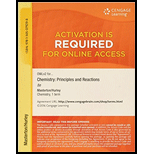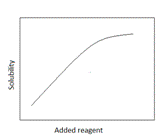
CHEMISTRY:PRIN.+REACTIONS-OWLV2 ACCESS
8th Edition
ISBN: 9781305079298
Author: Masterton
Publisher: Cengage Learning
expand_more
expand_more
format_list_bulleted
Concept explainers
Textbook Question
Chapter 15, Problem 72QAP
Dissolving CaCO3 is an endothermic reaction. The following five graphs represent an experiment done on CaCO3. Match the experiment to the graph.
(a) HCl is added.
(b) The temperature is increased.
(c) CaCl2 is added.
(d) NaCl is added.

Expert Solution & Answer
Trending nowThis is a popular solution!

Students have asked these similar questions
Thermodynamic analysis of electrified interfaces.
Conduct a brief thermodynamic analysis of electrified interfaces. Gibbs model.
ELECTROCAPILAR EQUATION FOR IDEALLY POLARIZED ELECTRODES.
Chapter 15 Solutions
CHEMISTRY:PRIN.+REACTIONS-OWLV2 ACCESS
Ch. 15 - Write a net ionic equation for the reaction...Ch. 15 - Write a net ionic equation for the reaction...Ch. 15 - Write a balanced net ionic equation for the...Ch. 15 - Write a balanced net ionic equation for the...Ch. 15 - Calculate K for the reactions in Question 1.Ch. 15 - Calculate K for the reactions in Question 2.Ch. 15 - Calculate K for the reactions in Question 3.Ch. 15 - Calculate K for the reactions in Question 4.Ch. 15 - Calculate [H+] and pH in a solution in which...Ch. 15 - Calculate [OH-] and pH in a solution in which the...
Ch. 15 - A buffer is prepared by dissolving 0.0250 mol of...Ch. 15 - Prob. 12QAPCh. 15 - A buffer solution is prepared by adding 15.00 g of...Ch. 15 - A buffer solution is prepared by adding 5.50 g of...Ch. 15 - A solution with a pH of 9.22 is prepared by adding...Ch. 15 - An aqueous solution of 0.057 M weak acid, HX, has...Ch. 15 - Which of the following would form a buffer if...Ch. 15 - Which of the following would form a buffer if...Ch. 15 - Calculate the solubility (in grams per liter) of...Ch. 15 - Calculate the solubility (in grams per liter) of...Ch. 15 - Copper(l) chloride, CuCl, is the starting material...Ch. 15 - Prob. 22QAPCh. 15 - Prob. 23QAPCh. 15 - Ksp for CaSO4 at 100C is estimated to be1.6105. At...Ch. 15 - Prob. 25QAPCh. 15 - At 25C, 10.24 mg of Cr(OH)2 are dissolved in...Ch. 15 - Calcium nitrate is added to a sodium sulfate...Ch. 15 - Cadmium(ll) chloride is added to a solution of...Ch. 15 - Water from a well is found to contain 3.0 mg of...Ch. 15 - Silver(I) sulfate (Ksp=1.2105) is used in the...Ch. 15 - A solution is prepared by mixing 13.00 mL of...Ch. 15 - A solution is prepared by mixing 45.00 mL of 0.022...Ch. 15 - A solution is 0.047 M in both NaF and Na2CO3....Ch. 15 - Solid lead nitrate is added to a solution that is...Ch. 15 - A solution is made up by adding 0.632 g of barium...Ch. 15 - A solution is made up by adding 0.839 g of...Ch. 15 - Prob. 37QAPCh. 15 - To a beaker with 500 mL of water are added 95 mg...Ch. 15 - Write net ionic equations for the reaction of H+...Ch. 15 - Prob. 40QAPCh. 15 - Prob. 41QAPCh. 15 - Write a net ionic equation for the reaction with...Ch. 15 - Prob. 43QAPCh. 15 - Write a net ionic equation for the reaction with...Ch. 15 - Prob. 45QAPCh. 15 - Write an overall net ionic equation and calculate...Ch. 15 - Consider the reaction...Ch. 15 - Consider the reaction BaF2(s)+SO42(aq)BaSO4(s)+2...Ch. 15 - Aluminum hydroxide reacts with an excess of...Ch. 15 - Prob. 50QAPCh. 15 - Calculate the molar solubility of gold(I) chloride...Ch. 15 - Calculate the molar solubility of PbCl2 in 0.2 M...Ch. 15 - For the reaction...Ch. 15 - For the reaction Zn(OH)2(s)+2OH(aq)Zn(OH)42(aq)...Ch. 15 - What are the concentrations of Cu2+, NH3, and...Ch. 15 - Prob. 56QAPCh. 15 - Calcium ions in blood trigger clotting. To prevent...Ch. 15 - Prob. 58QAPCh. 15 - A town adds 2.0 ppm of F- ion to fluoridate its...Ch. 15 - Consider the following hypothetical dissociation:...Ch. 15 - Prob. 61QAPCh. 15 - Consider a 2.0-L aqueous solution of 4.17 M NH3,...Ch. 15 - Marble is almost pure CaCO3. Acid rain has a...Ch. 15 - Prob. 64QAPCh. 15 - Prob. 65QAPCh. 15 - The box below represents one liter of a saturated...Ch. 15 - Consider a saturated solution of BaCO3 at 7.5C....Ch. 15 - Prob. 68QAPCh. 15 - Consider the insoluble salts JQ, K2R, L2S3, MT2,...Ch. 15 - Prob. 70QAPCh. 15 - Consider the equilibrium curve for AgCl shown...Ch. 15 - Dissolving CaCO3 is an endothermic reaction. The...Ch. 15 - Challenge Problems Insoluble hydroxides such as...Ch. 15 - What is the solubility of CaF2 in a buffer...Ch. 15 - What is [Br-] just as AgCl begins to precipitate...Ch. 15 - Prob. 76QAPCh. 15 - Prob. 77QAPCh. 15 - Prob. 78QAP
Knowledge Booster
Learn more about
Need a deep-dive on the concept behind this application? Look no further. Learn more about this topic, chemistry and related others by exploring similar questions and additional content below.Similar questions
- Briefly state the electrocapillary equation for ideally polarized electrodes.arrow_forwardWhat is surface excess according to the Gibbs model?arrow_forwardUsing Benzene as starting materid show how each of the Following molecules Contel Ve syntheswed CHI 9. b -50311 с CHY 503H Ночто d. อ •NOV e 11-0-650 NO2arrow_forward
- The molecule PYRIDINE, 6th electrons and is therefore aromatre and is Assigned the Following structure contering Since aromatk moleculoy undergo electrophilic anomatic substitution, Pyridine shodd undergo The Following reaction + HNO3 12504 a. write all of the possible Mononitration Products that could Result From this reaction 18. Bared upon the reaction mechanison determime which of these producty would be the major Product of the hegetionarrow_forwarda. Explain Why electron withdrawing groups tend to be meta-Directors. Your answer Should lyclude all apropriate. Resonance contributing Structures fo. Explain why -ll is an outho -tura drccton even though chlorine has a very High Electronegativityarrow_forward9. Write Me product as well as the reaction Mechanism For each of the Following Vanctions +H₂504 4.50+ T C. +212 Fellz 237 b. Praw the potential energy Diagrams For each OF Mese Rauctions and account For any differences that appear in the two potential Puergy Diagrams which of here two reactions 19 Found to be Reversable, Rationalice your answer based upon the venation mechanisms and the potential energy diagrams.arrow_forward
- 9. Write Me product as well as the reaction Mechanism For each of the Following Veritious +H2504 4.50+ + 1/₂ Felly ◎+ 7 b. Praw he potential energy Diagrams For each OF Mese Ronctions and account for any differences that appeak in the two potential Puergy Diagramsarrow_forwardDraw the major product of this reaction. Ignore inorganic byproducts. Incorrect, 3 attempts remaining 1. excess Br2, NaOH 2. neutralizing workup Qarrow_forwardGiven the electrode Pt | Ag | Ag+ (aq), describe it.arrow_forward
- At 25°C, the reaction Zn2+ + 2e ⇄ Zn has a normal equilibrium potential versus the saturated calomel electrode of -1.0048 V. Determine the normal equilibrium potential of Zn versus the hydrogen electrode.Data: The calomel electrode potential is E° = 0.2420 V versus the normal hydrogen electrode.arrow_forwardElectrochemistry. State the difference between E and E0.arrow_forwardIn an electrolytic cell, the positive pole is always assumed to be on the right side of the battery notation. Is that correct?arrow_forward
arrow_back_ios
SEE MORE QUESTIONS
arrow_forward_ios
Recommended textbooks for you
 Chemistry & Chemical ReactivityChemistryISBN:9781133949640Author:John C. Kotz, Paul M. Treichel, John Townsend, David TreichelPublisher:Cengage Learning
Chemistry & Chemical ReactivityChemistryISBN:9781133949640Author:John C. Kotz, Paul M. Treichel, John Townsend, David TreichelPublisher:Cengage Learning Chemistry & Chemical ReactivityChemistryISBN:9781337399074Author:John C. Kotz, Paul M. Treichel, John Townsend, David TreichelPublisher:Cengage Learning
Chemistry & Chemical ReactivityChemistryISBN:9781337399074Author:John C. Kotz, Paul M. Treichel, John Townsend, David TreichelPublisher:Cengage Learning Introductory Chemistry: A FoundationChemistryISBN:9781337399425Author:Steven S. Zumdahl, Donald J. DeCostePublisher:Cengage Learning
Introductory Chemistry: A FoundationChemistryISBN:9781337399425Author:Steven S. Zumdahl, Donald J. DeCostePublisher:Cengage Learning Chemistry: The Molecular ScienceChemistryISBN:9781285199047Author:John W. Moore, Conrad L. StanitskiPublisher:Cengage Learning
Chemistry: The Molecular ScienceChemistryISBN:9781285199047Author:John W. Moore, Conrad L. StanitskiPublisher:Cengage Learning General Chemistry - Standalone book (MindTap Cour...ChemistryISBN:9781305580343Author:Steven D. Gammon, Ebbing, Darrell Ebbing, Steven D., Darrell; Gammon, Darrell Ebbing; Steven D. Gammon, Darrell D.; Gammon, Ebbing; Steven D. Gammon; DarrellPublisher:Cengage Learning
General Chemistry - Standalone book (MindTap Cour...ChemistryISBN:9781305580343Author:Steven D. Gammon, Ebbing, Darrell Ebbing, Steven D., Darrell; Gammon, Darrell Ebbing; Steven D. Gammon, Darrell D.; Gammon, Ebbing; Steven D. Gammon; DarrellPublisher:Cengage Learning Chemistry by OpenStax (2015-05-04)ChemistryISBN:9781938168390Author:Klaus Theopold, Richard H Langley, Paul Flowers, William R. Robinson, Mark BlaserPublisher:OpenStax
Chemistry by OpenStax (2015-05-04)ChemistryISBN:9781938168390Author:Klaus Theopold, Richard H Langley, Paul Flowers, William R. Robinson, Mark BlaserPublisher:OpenStax

Chemistry & Chemical Reactivity
Chemistry
ISBN:9781133949640
Author:John C. Kotz, Paul M. Treichel, John Townsend, David Treichel
Publisher:Cengage Learning

Chemistry & Chemical Reactivity
Chemistry
ISBN:9781337399074
Author:John C. Kotz, Paul M. Treichel, John Townsend, David Treichel
Publisher:Cengage Learning

Introductory Chemistry: A Foundation
Chemistry
ISBN:9781337399425
Author:Steven S. Zumdahl, Donald J. DeCoste
Publisher:Cengage Learning

Chemistry: The Molecular Science
Chemistry
ISBN:9781285199047
Author:John W. Moore, Conrad L. Stanitski
Publisher:Cengage Learning

General Chemistry - Standalone book (MindTap Cour...
Chemistry
ISBN:9781305580343
Author:Steven D. Gammon, Ebbing, Darrell Ebbing, Steven D., Darrell; Gammon, Darrell Ebbing; Steven D. Gammon, Darrell D.; Gammon, Ebbing; Steven D. Gammon; Darrell
Publisher:Cengage Learning

Chemistry by OpenStax (2015-05-04)
Chemistry
ISBN:9781938168390
Author:Klaus Theopold, Richard H Langley, Paul Flowers, William R. Robinson, Mark Blaser
Publisher:OpenStax
Calorimetry Concept, Examples and Thermochemistry | How to Pass Chemistry; Author: Melissa Maribel;https://www.youtube.com/watch?v=nSh29lUGj00;License: Standard YouTube License, CC-BY